Vehicle tracking systems are increasingly popular for grey fleet management. Tracking can solve many of the problems of grey fleet management by going beyond the company vehicle inspection checklist. The result is increased driver safety and reduced fuel costs. However, tracker use must achieve fleet vehicle compliance. For managers, it’s a balancing act between increased fleet oversight and driver privacy. Our step-by-step guide is designed to help you and your grey fleet meet best practice guidelines for GPS tracker use.
The law and vehicle tracking
Using vehicle tracking is legal in the UK if:
- Your grey fleet drivers know they’re being tracked.
- They consent to being tracked.
- They’re only tracked during their working hours.
- You track the vehicle, not the individual.
Any information you collect on your grey fleet via GPS tracking is considered personal data. Therefore, it must be treated and stored in compliance with GDPR. That means:
- You should only collect the data you need for business purposes.
- Data is collected and kept in compliance with GDPR.
- Only people with a legitimate reason for seeing the data can access it.
How to legally track your grey fleet
Tracking grey fleet vehicles makes good business sense. Vehicle tracking increases fleet vehicle compliance when implemented alongside your vehicle document checks. Additionally, you can map out faster routes, monitor driver behaviour, and increase fuel efficiency. But to stay on the right side of the law, you’ll need to implement best practices for GPS tracking.
Keep drivers informed
Before implementing any car tracking, inform your drivers that you’ll install trackers and collect data. This is essential for fleet vehicle compliance, as monitoring your drivers without their consent is illegal. Document any objections and deal with them with complete transparency. Explain the way that vehicle tracking can improve workflows. Explain how tracking can be used for fleet vehicle compliance and what driver behaviours will be monitored. Include an employee vehicle inspection checklist, clearly listing the GPS tracking device.
Implement a vehicle tracking policy
Write up a clear policy on vehicle tracking and get your fleet drivers’ consent, preferably in writing. Your policy should inform drivers:
- Why you’re tracking grey fleet vehicles
- The data you’ll collect
- How the data will be used to benefit the business.
- How the data will be stored.
- How the data will be used in any disciplinary action.
Safeguard sensitive data
You have a duty under GDPR to safeguard any personal information you collect. Data must comply with the General Data Protection Regulation, ensuring data storage is robust and data sharing is minimised. Implement security measures, including password protection, and ensure all data is up-to-date.
Comply with driver privacy
If you intend to implement vehicle tracking across your grey fleet, ensure privacy settings are available. It’s illegal to track your drivers outside of working hours, so look for the following features:
- A privacy button for drivers to use when they go off duty.
- A timer that automatically disables the tracker at a set location or time.
- The ability to disable the tracker remotely.
Track the car, not the individual
Any data you collect must be for legitimate business reasons, such as route optimisation. A tracker should never be used to monitor individuals, in or out of working hours. Failure to comply could result in a fine.
Ensure you collect the correct data
As a grey fleet manager, you must ensure all devices are operational. Any form of GPS jamming is illegal as it tampers with the data you collect. You must protect your devices from software that alters or compromises the data in any way.
Stay compliant with Safe2Drive
At Safe2Drive, we offer the most innovative fleet-checking solution in the UK. Contact us today to find out how we can help you achieve grey fleet vehicle compliance.

